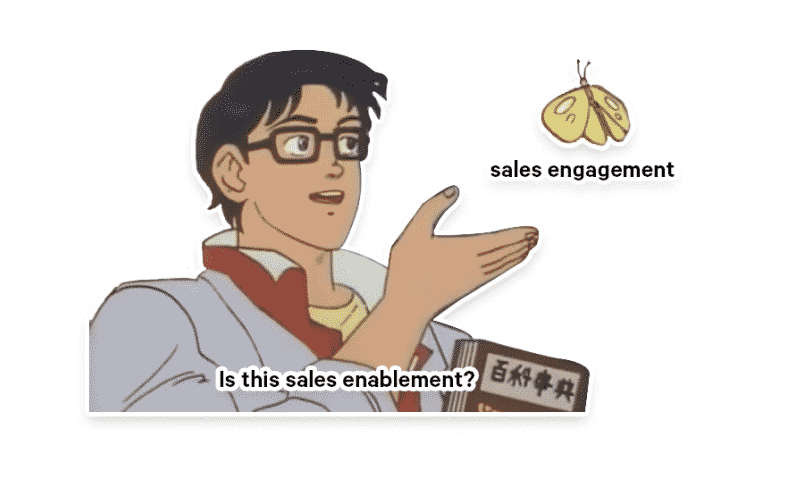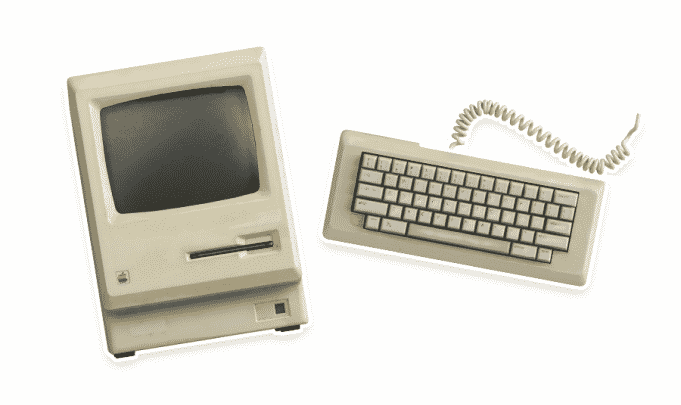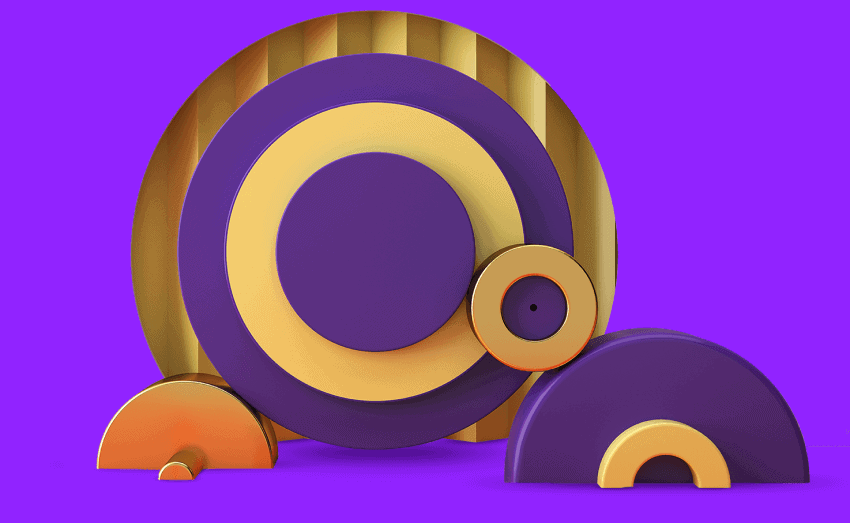
The Definitive Guide To Sales Engagement
Table of contents
Sales is getting harder. Yesterday’s tactics don’t work as well today. Prospects aren’t picking up your calls, your email reply rate is dropping, and you have no meetings booked.
The way we approach sales has to change. That’s where sales engagement comes in. By promoting strong engagement between your sales team and prospective buyers, you can build better relationships and boost your sales. This power page will help you understand what exactly Sales Engagement is, why it’s essential, and how to get started.

An introduction to Sales Engagement
What is Sales Engagement?
Put simply (and rather unsurprisingly), Sales Engagement refers to all interactions (or engagement) between the seller and buyer throughout the sales process, traditionally measured in time and touchpoints.
That cold email you sent out? That voicemail you left? That comment you left on their post? That’s all part of sales engagement.
Still, it takes more than just sending an email or making a call to engage with your prospects. By planning, analyzing, and optimizing those interactions, you can improve your engagement and focus on building a genuine business relationship with the buyer.
This often means contacting their prospects across different channels, such as SMS messaging and social media. This may not even be a direct message; a social media touchpoint on LinkedIn might mean visiting their profile, liking their post, or leaving a comment.
Sales engagement potentially covers any platform or method for engaging with your prospective customers:
You might have noticed that there are also some ‘old-school’ platforms included in our list, most notably direct mail. Far from being dead, sending physical mail to your prospects is a great way to stand out from your competition and grab your prospect’s attention. A massive 80-90% of direct mail is opened, the highest percentage for outbound channels; how does that compare to your email open rates? Companies like Sendoso and Reachdesk allow you to easily send postcards, letters, gifts and more to your prospects.
Sales engagement doesn’t have to be just about one-on-one communication though. The same principles can be used with account-based selling (ABS) and account-based marketing (ABM) platforms. For example, after researching a bigger company, you can target your outreach to that company’s employees as part of their sales engagement plan.
Whatever channel or platform you’re using, the objective is the same—to build a genuine relationship with the buyer. When you’re building your sales engagement strategy, evaluate each tool, channel, and strategy against those criteria.
Is it the same as sales enablement?
With the increasing popularity of sales engagement, many sales teams are wondering where it fits in with their current strategies. What’s the difference between sales engagement and similar terms, such as sales enablement and sales automation?
Sales enablement is all about making sure your sales team has all the skills, knowledge, and tools necessary to do their job: closing more leads. As a result, it may also include sales automation. However, by itself, sales enablement is not the same as sales engagement. In some companies, it’s a completely separate department.
It’s best to think of sales enablement as the strong foundation your sales team needs. Sales engagement is the successful execution, built off of that foundation. While they’re different and distinct strategies, they’re closely connected. Without proper enablement, it’s much harder for sales teams to engage with their prospects.
Here is the table to ease the comparison:
| Aspect | Sales engagement | Sales enablement |
| What it is | Tools and strategies to help reps interact with buyers. Think: emails, calls, demos, and all the touchpoints. | The foundational support system for reps to sell effectively. Think: training, content, and processes. |
| Primary focus | Improving interactions with buyers. | Equipping reps internally with resources to sell better. |
| Core activities | Email sequencing, meeting scheduling, tracking buyer activity, personalized outreach. | Providing pitch decks, product training, competitive insights, and playbooks. |
| Tools used | CRM integrations, outreach platforms (e.g., Reply.io), engagement analytics. | Learning management systems, content libraries (e.g., Highspot, Seismic), CRM tools. |
| Outcome goal | More effective, personalized, and timely communication with prospects = faster sales cycles. | Well-prepared and confident reps = improved win rates and team productivity. |
| Who’s involved? | Sales reps, SDRs, and Account Executives working directly with buyers. | Sales managers, enablement specialists, product marketing, and training teams. |
| When it’s used | During the active selling process—when talking to leads or prospects. | Pre- and post-selling stages—prepping reps before they even talk to buyers. |
| How it feels | “How do I connect better with this specific buyer right now?” | “How do I make sure our whole team is always prepared to close deals?” |
| Success metrics | Engagement rates (e.g., email opens, meeting booked), sales velocity, win rates. | Ramp-up time, content usage, sales rep performance, quota attainment. |
| Simple snalogy | Think car racing: This is your driver’s direct moves on the track. | Think car racing: This is the pit crew giving the car fuel, tools, and strategy. |
| Core problem solved | “How do I engage buyers better in real-time?” | “How do I ensure my reps are equipped to succeed every time?” |
This table should help you quickly distinguish between the two while keeping it practical and actionable.
Is it the same as sales automation?
Now, let’s switch gears to sales automation. This is all about efficiency. It’s the behind-the-scenes magic that makes sure you’re not manually typing the same email 100 times or copying data between tools.
Examples of sales automation:
- Automatically sending a follow-up email if a prospect hasn’t responded within three days.
- Logging calls, emails, and interactions into your CRM without lifting a finger.
- Moving a lead from one stage of the pipeline to another based on specific triggers (e.g., when they open an email or book a demo).
Sales automation doesn’t replace the personal touch, but it streamlines repetitive tasks so your sales reps can focus on what they do best—closing deals. To compare, sales engagement is hands-on. It requires strategy, creativity, and often a human touch. Think of it as the way you’re showing your buyer, “Hey, I get you. Here’s why this product solves your problem.”
Here is the table to make everything super-clear (yet super-simple):
| Aspect | Sales engagement | Sales automation |
| Purpose | Building relationships with buyers. | Automating repetitive sales tasks to save time. |
| Focus | Personalization and meaningful interactions. | Efficiency and scalability of processes. |
| Examples | Sending tailored messages, making personalized calls. | Auto-follow-ups, CRM updates, lead scoring. |
| Requires human input? | Yes—sales reps play a big role. | No—mostly runs in the background. |
And here’s the thing: sales engagement and sales automation are better together. One isn’t a replacement for the other—they complement each other perfectly. Imagine this scenario:
- You’re an SDR reaching out to a lead. Sales automation handles the boring stuff, like pulling the prospect’s email address and scheduling reminders to follow up.
- Then, you step in with sales engagement, crafting a thoughtful email that references a specific pain point you noticed in their latest LinkedIn post.
When paired, automation frees up your time, so you can focus on creating impactful, personalized engagement that resonates with your buyers.
Why sales engagement matters
Sales is getting more difficult and complex today. Tired of the impersonal cold outreach that has become so popular, prospects are looking for more. They want more genuine personalization, more value, and in the channels that suit them. While you may have been able to get away with a simple sequence of emails and/or phone calls in the past, companies are starting to recognize the need to be more creative.
From my personal experience, I noticed my positive reply rates were getting lower and lower. To get the same results, we need to give our prospects what they want. We need to spend more time on personalization and add more value to every touchpoint.
To do that effectively, we need to have very specific targeting. We have to segment our sequences, creating unique messages based on such criteria as title, industry, value proposition and pain points.
In today’s world, you simply can’t rely just on emails anymore. That’s one of the reasons we’ve expanded the Reply’s functionality beyond just email. Before I would describe Reply as an email sending platform, but now we can integrate with other platforms to use different channels and, as a result, it’s easier for me to find more qualified opportunities. When we added our Vidyard integration to Reply and I started using it to send personalized videos as a step in our sequence, I was able to book 10 meetings within just a few days.

Tracking your sales engagement also allows you to optimize your processes. Many people accept that we should be measuring the performance for the individual steps of the sales process, but keeping track of and optimizing the complete process—from the first touchpoint to the last—is even more important.
Along with your existing process, sales engagement also helps speed up your onboarding and other training for the sales team. By seeing which sequences work best for your target market, you can quickly train up your team on the most effective practices. Of course, measuring your sequence performance is a lot easier if you’re using a dedicated sales engagement platform.

Another benefit of using a SE platform is being able to keep all your details in one place. When you integrate all your sales-related tools, for instance, for scheduling meetings, tracking your phone calls, finding leads, tracking your opens and clicks, etc, having all those details in one place makes it easier to find your best opportunities. For instance, I usually start my day by going to my Reply account and filtering my leads based on views. I’ll then send personalized videos to any leads who’ve opened my emails more than ten times. Being able to do this all within the same platform is more efficient, saving time and giving me an overall view of my sales pipeline.
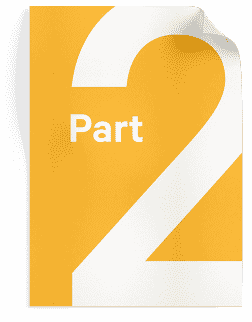
First steps with Sales Engagement
Who should use Sales Engagement?
Hopefully, you’re now convinced of the importance of actively pursuing a sales engagement strategy. However, who exactly should be using sales engagement? Is it specific to a particular role?
In short, everyone in the sales team can benefit from sales engagement. In fact, to get the full benefit of sales engagement, everyone needs to use the sales engagement platform.
For SDRs, sales engagement is their number one tool and they should be using it every single day. Account executives should also be using sales engagement tools to follow up on lost opportunities etc. If you’re in sales operations, for example as VP of Sales, you should be using sales engagement to track your organization’s sales activities. From there you can see which sequences work better, who the top performers are in your team, which SDRs are driving better results and so on. Everyone in the sales organization can and should be using sales engagement.
However, it’s not just limited to the sales teams—Marketing teams can also be involved. At Reply our marketing team is responsible for, among other things, generating leads from downloaded lead magnets or onsite chats with our bot. They’ll then send the sales team a list of those leads and the SDRs will reach out to them. To improve that workflow, you can integrate marketing automation tools like Active Campaign with your sales engagement platform (either using a built-in integration where available or a tool like Zapier) to push the hottest leads automatically. For instance, one of our customers has integrated MailChimp with Reply, pushing all leads who’ve opened their newsletter three or more times to Reply.
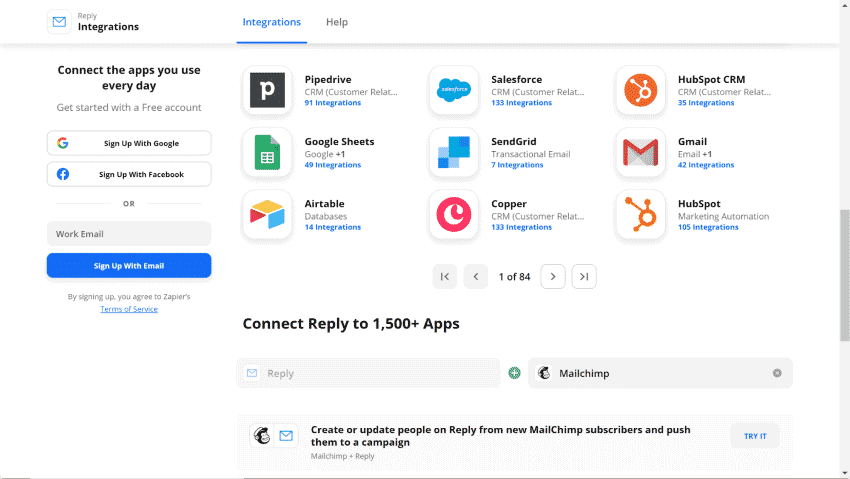
Particularly in smaller companies, CMOs are usually super involved in the sales process, and may even be the decision-maker when it comes to what sales tools to use. Your sales and marketing departments should always be aligned, and making sure they’re both involved in your sales engagement is one way to achieve that.
What software do you need?
It’s important to acknowledge you don’t technically need dedicated sales engagement software to engage more with your prospects. You could get away with just using a CRM, maybe an emailing tool as well. However, that’s going to ineffective. Let’s be clear: having a B2B sales engagement platform makes the whole sales engagement process a million times easier. When I get on a call with a company, the first question I ask is what sales engagement platform they’re using. If they’re not using a platform, I know it’s going to be much harder to get the results they want.
Companies are already having to look at using additional sales channels, and that number of channels is only going to increase over time. Going forward, having a sales engagement platform won’t be a nice optional extra; it’ll be essential. If you’re not already using a dedicated sales engagement platform, there’s no reason to put it off any longer. The sooner you get started, the greater your advantage.
An outreach sales engagement platform (like Reply) will be capable of either directly managing those multiple sales channels or can easily integrate with other apps that can. For example, Reply now includes features from Vidyard (so users can send personalized videos to prospects) and Twilio (letting users make cloud calls directly from the platform). You can then see how your prospect has reacted to your outreach.
For example, how many times have they opened your email? How many times have they watched your video? How many times have they opened your attachment? With everything in one place, you can easily view all the buyer signals across multiple channels. That makes it easier for a sales rep to prioritize their pipeline and focus on the leads most likely to convert.

Whether you’re looking for a standalone solution or want to DIY and build your own sales engagement platform, there are several components you’ll need to consider:
Communication channels. How are you engaging with your prospects? Be sure to include social media engagement and not just direct communication. By using LinkedIn connection requests as a step in my sequence, I was able to generate 100 quality new connections in just one day.
Content management. What messages are you going to use to engage with your prospects? This might include email templates, phone scripts, and long-form content you share.
Automation. How are you going to scale your engagement? By careful, selective use of automation, you can focus on genuine personalization that fosters engagement, rather than having to worry about any repetitive tasks in the process.
Results. How are you going to keep track of your engagement? Can you tell what the best performing channels and messages are? If you want your sales engagement to be more than guesswork, you need to keep track of how your sequences perform. Besides, without tracking your engagement, the next step is impossible…
Optimization. Sales engagement shouldn’t just be a one-time thing. To get the full benefits, you’ll need to analyze your results, then identify where there’s room for improvement.
Your secret weapon – AI
Imagine having a tool that finds the perfect leads, writes killer emails, and even whispers advice during calls. Sounds amazing, right? Let’s break it down with practical examples to show how AI can supercharge your sales engagement.
1. Smarter prospect targeting
Picture this: You’re scrolling through a list of 500 leads. How do you know which ones are worth your time? Sales engagement solution like Reply.io step in here. They analyze data—job titles, industries, past interactions—and rank your leads from “most likely to convert” to “probably not today.”
Example: Instead of emailing 500 random prospects, you focus on the top 50 leads flagged by AI. One of them, let’s call her Sarah, just opened your email 10 times and visited your website twice. AI tells you, “Hey, this one’s hot!” You send her a personalized message, and she books a meeting within the hour.
2. Personalization at scale
We all know personalization is key, but who has time to write custom emails for every lead? Enter AI.
It scans Sarah’s LinkedIn profile, notices she recently posted about scaling her sales team, and suggests this opener: “Hi Sarah, I saw your post about scaling your sales team—congrats on the growth! We’ve helped companies like [Similar Company] streamline their hiring process. Mind if I share how?”
Example: Using an AI tool like ChatGPT, you tweak the email in seconds and hit send. Sarah replies, “Wow, this feels so relevant. Let’s talk!”
3. Optimized engagement sequences
Imagine you’re running a multi-step email campaign. Instead of guessing the timing, AI predicts the best times to send emails and recommends adjustments on the fly. For instance, Sarah hasn’t opened your last two emails but clicked your LinkedIn profile.
Example: AI suggests switching to a LinkedIn message:
“Hi Sarah, I noticed you checked out our profile—thanks! Let me know if there’s anything specific I can help with.”
Minutes later, Sarah responds: “I was just thinking about reaching out. Let’s set up a call!”
4. Real-time coaching
You’re on a call with Sarah. She mentions concerns about pricing. AI tools like Gong analyze the conversation live and suggest: “Highlight ROI—mention how other clients reduced costs by 20%.”
Example:
- You say, “I completely understand, Sarah. Just to share, one of our clients in your industry cut their overhead by 20% using our platform. Would you like to see how?”
- Sarah replies, “That’s exactly what I need!”
5. Predictive analytics
Let’s say Sarah books a meeting but goes quiet afterward. You’re not sure whether to keep pursuing her or focus on another lead. AI looks at her engagement history and predicts a 70% chance she’ll close if you re-engage within two days.
Example:
AI sends you a reminder: “Follow up with Sarah today!” You send a quick text:
“Hi Sarah, just circling back—happy to answer any lingering questions. Let’s pick a time to chat.”
She replies, “Thanks for following up. Let’s lock in Friday.”
Planning out your sales engagement
With the right tools in place, you’re ready for the next step: deciding what your engagement will look like.
Decide what communication channels you need
A key part of sales engagement is creating a multi-channel sequence. If you’re going to engage with your prospects, you need to think about what channels they use and where they’re most likely to engage. However, if you’re only using the single ‘most-effective’ channel, your engagement won’t match how people use these channels. Nobody sticks to just one channel anymore. They’ll use a huge number of different channels for different purposes. If you’re just using one channel, your campaign is much less likely to make any kind of impact. Think about all the potential channels you can use, considering both which channels are easiest to use, offer the highest ROI, and that your prospective customers are active in.

Decide on how many touchpoints you’ll use
How many touchpoints should your sales engagement have? The answer will depend on who you ask. I’ve seen people recommend everything from 3 to 33. Still, one thing most sales professionals agree on is that the number of touchpoints needed to engage with your prospect is increasing. The most common sequences contain multiple touches across multiple channels, usually to be carried out across between two and four weeks depending on how aggressive they want to be.
Here’s an example of one of the more aggressive sequences, set across just 10 days, that you might consider using:
Day #
Phone call + Voicemail
Automated email + LinkedIn engagement (e.g. connection request, profile view, etc.)
Personalized email + Voicemail
Phone call, Voicemail, + LinkedIn engagement
Breakup email + LinkedIn engagement
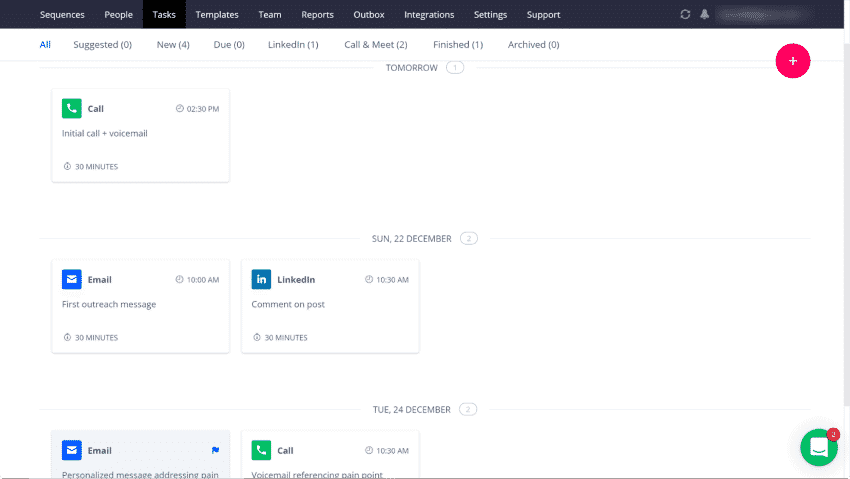
Think about what the ideal sequence of touchpoints might look like for your prospective customers, but don’t overthink it. You will be coming back and optimizing your sequence later on, so the most important thing is to get started.
Bonus. Looking for some more potential sequences to steal for inspiration? We’ve got you. Here are four more sequences, direct from our very own best practices checklist:
Do your research
To create a genuinely engaging sequence, you’ll need to prepare thoroughly. Along with deciding on what channels and how many touchpoints you’ll use, you’ll also need to find the raw data needed for your campaign. This includes your prospect’s contact details: email address, phone numbers, social profiles, etc., but also the details you’ll need to create a genuine connection (such as their pain points).
Craft the perfect message for the perfect format
It’s getting harder to find a creative way to send a personalized message. Everyone’s talking about personalization and how with just five minutes of research you can create a magical personalized email. Unfortunately, that means any ideas you hear being promoted for personalization are getting overused. Even if they were effective at one point, they’re not anymore.
For example, I no longer recommend people use funding data or site visits as a personalization snippet anymore. Becc Holland of Chorus.ai (who’s super cool in terms of sales development) talks about how you should use information like funding data as your invisible sales signal. In other words, you can build your list with companies that recently got a new round of funding, but don’t mention that in your email. It’s better to spend more time on research and personalize something else (for instance hiring signals).
When it comes down to crafting your message, I recommend using the Jobs To Be Done framework: “When I ___, I want to ___, so I can___.” Use this to understand your prospects, what’s important to them, and why they’d be interested in what you’re selling. For instance, “When I choose a sales engagement platform, I want to track my opportunities effectively, so I can exceed my quota.” Based on that framework, you can craft the perfect message for every single title you’re reaching out to.
What to track and why in sales engagement
Let’s be honest—if you’re not tracking your sales engagement efforts, how do you know what’s working (and what’s a total flop)? Measuring the right metrics is like having a GPS for your sales strategy. It tells you where you’re crushing it and where you’re spinning your wheels.
Here’s a super-practical, no-nonsense breakdown of the key metrics you should be tracking in sales engagement—and why they matter.
| Metric | What It Tells You | Pro Tip |
| Email open rate | Measures how many recipients open your emails, reflecting subject line effectiveness and targeting. | Aim for 20-30%. Test subject lines using curiosity, personalization, or direct value propositions. |
| Reply rate | Shows how many recipients respond to your emails, indicating message relevance and personalization. | Tailor your emails with specific insights about the recipient or their business challenges. |
| Call connection rate | Tracks how often your calls reach actual prospects instead of voicemail, indicating timing effectiveness. | Experiment with call times; late mornings and early afternoons often yield better results. |
| Meeting booking rate | Tracks how successful you are in converting engagements into scheduled meetings. | Use clear, compelling CTAs and remove friction with easy scheduling tools like Calendly. |
| Lead-to-opportunity conversion | Measures the percentage of leads that move into qualified opportunities, reflecting sequence effectiveness. | Regularly review and refine your sequences to ensure they resonate with your target audience. |
Here is how to use them:
- Analyze patterns → identify what’s driving high open, reply, or booking rates and replicate those strategies.
- Fix gaps → spot low connection or conversion rates to uncover areas needing improvement.
- Iterate & optimize → continuously test and tweak subject lines, call scripts, and sequence timing for better results.
With this table as your guide, tracking sales engagement metrics becomes a breeze (we hope so!).
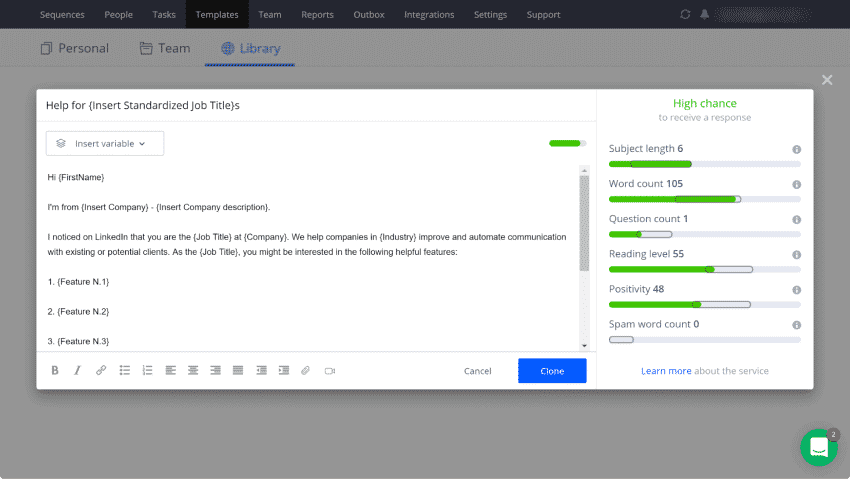

Avoid common sales engagement mistakes
Once you’ve got the right tools and you’ve decided on the right messaging for each channel, you’re ready to hit send. Congratulations! But that doesn’t mean you can just set it and forget it. To get the best results, you’ll need to analyze and optimize your campaigns.
As you do so, beware of these common mistakes:
Measuring the performance of each touchpoint in isolation. You may find that certain channels offer better results, and choose to double down on them. However, you need to look at the campaign performance as a whole, and not just one isolated step. Just because someone replied to your emails but didn’t respond to your social media engagement, that doesn’t mean you should immediately stop all social media touchpoints. It’s highly likely that even if they didn’t directly lead to a response, they still assisted in the process.

Not balancing quality and quantity.
We’ve always been a fan of personalizing our emails at Reply. It’s no good spraying out thousands of bland, impersonal emails. However, personalization takes time. How long should you spend perfecting that one message that’s only relevant for one client? We handle that at Reply by dividing our ideal customers into three different tiers:
Perfect customers. These are the customers who tick all the boxes, such as industry, company size, location, and revenue.
Almost perfect customers. They look very similar to your perfect customer, and have a lot of the same criteria, but don’t completely match your perfect vision.
Everyone else. These are the customers who can still get value from your product/service, but otherwise don’t look like your typical customer.
For tier one prospects, thoroughly research and personalize all your messaging. For tier two, only personalize messages for the most relevant positions. For tier three, keep personalization to a minimum and rely on automated outreach.
Always looking for more sales tools.
FOMO (the fear of missing out) is a real danger for sales teams. It’s easy to be constantly looking for the next best tool, the new shiny object that will change everything. When you find yourself looking longingly at yet another sales tool, ask yourself if you really need it. Does it add to or substantially improve your existing process? Or do you already have tools that can do the same job? Overcomplication makes it harder for your SDRs to get familiar with their tools and their sales processes. Each new sales tool means you need to onboard your team and document new processes and procedures. It’s better to have a handful of tools you can expertly use, rather than hundreds that you use once and never again. Try at least one or two tools in each category and find the perfect solution for every business.
Letting your processes get stale.
As a sales professional, it’s essential to keep on top of any new trends. For example, growth advisor Guillaume Cabane shared how he’d ask website visitors if they wanted a tea or a coffee, via a chat window, which he’d then have delivered to them. That’s helped boost their conversions. But when he told everyone about that experiment, lots of other B2B companies starting using the same approach and it quickly became overused. That’s why it’s important to stay ahead of whatever everyone else is doing. It helps to read a lot about what new trends, new tools, and new approaches are out there. However, to get ahead of the competition, you need to start experimenting and inventing new tactics yourself. Then, when you create that next tactic, avoid sharing it for at least six months, so you can get the full benefits!
Sales engagement is far more than just a trendy buzz-term. Rather, it covers your whole attitude to sales and is essential if you want to stand out. By using a sales platform to reach your prospects on the channels they’re using, by engaging with them, and then enabling your whole team to get the same results, you’ll be able to build genuine relationships with your prospects, leading to even greater sales.
